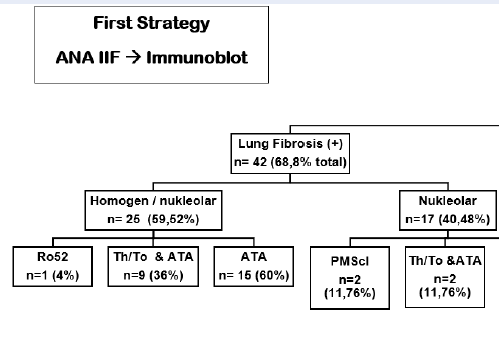Laboratory strategy for autoantibodies testing as a diagnostic marker of pulmonary fibrosis in systemic sclerosis: A preliminary study prior to cohort registry of systemic sclerosis in West Java Indonesia
DOI:
https://doi.org/10.15419/bmrat.v8i8.689Keywords:
ANA-IIF, autoantibodies screening, pulmonary fibrosis, SSc profile, systemic sclerosisAbstract
Background: Interstitial lung disease (ILD) is a complication often found in patients with Systemic Sclerosis (SSc). This usually manifests as pulmonary fibrosis and is the leading cause of death in SSc patients. Antinuclear antibodies indirect immunofluorescence (ANA-IIF) test and specific autoantibodies testing could be employed as a diagnostic marker to detect pulmonary fibrosis, but the high cost of these tests often burdens patients in developing countries. This study aims to compare ANA-IIF and an alternative, possibly inexpensive method to detect pulmonary fibrosis in SSc.
Methods: This is a preliminary study prior to the cohort systemic sclerosis registry conducted in Rheumatology Outpatient Clinic and Clinical Pathology Department at Dr. Hasan Sadikin General Hospital, Bandung, from January 1, 2018 to December 31, 2020. Two contrastive laboratory testing strategies were followed to confirm pulmonary fibrosis in 61 SSc patients. The first strategy was to perform antinuclear antibodies indirect immunofluorescence (ANA-IIF) test followed by specific autoantibodies detection [anti-topoisomerase-I (ATA), Anti-Th/To, SSc Profile, Immunoblot]. The alternative strategy included conducting the tests for SSc autoantibodies in the reverse order.
Results: A total of 42 out of 61 (68.8%) subjects were diagnosed with pulmonary fibrosis by high-resolution computed tomography (HRCT) scan. The first strategy detected dominant specific pulmonary fibrosis autoantibodies in subjects with pulmonary fibrosis: homogeneous nucleolar pattern was dominant (n = 25, 59.52%), followed by nucleolar pattern (n = 17, 40.48%). Of all the subjects with a homogeneous nucleolar pattern, ATA was detected in 15 subjects (60%), the combination of ATA and Th/To in 9 subjects (36%), and Ro52 in one subject (4%). The second strategy yielded positive autoantibodies results in 29 out of 42 (69.05%) subjects, ATA in 20 subjects (47.61%), and Th/To in 9 patients (21.44%), but failed to detect any autoantibodies specific to SSc-ILD in 13 subjects (30.95%).
Conclusion: The first strategy [ANA-IIF followed specific autoantibodies testing (ATA, Th/To, SSc profile and immunoblot)] is more likely to detect specific autoantibodies toward ILD in SSc patients.

Published
Issue
Section
License
Copyright The Author(s) 2017. This article is published with open access by BioMedPress. This article is distributed under the terms of the Creative Commons Attribution License (CC-BY 4.0) which permits any use, distribution, and reproduction in any medium, provided the original author(s) and the source are credited.
